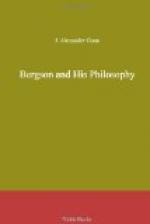Moreover, we must recognize that the image is formed and perceived in the object, not in the brain, even although it would seem that rays of light coming from a point P are perceived along the path of the sensori-motor processes in the brain and are afterwards projected into P. There is not, however, an unextended image which forms itself in consciousness and then projects itself into the position P. Really, the point P, and the rays which it emits, together with the retina and nervous elements affected in the process of perception, all form a single whole. The point P is an indispensable factor in this whole and it is really in P and not anywhere else that the image of P is formed and perceived.[Footnote: Cf. Matter and Memory, p. 37 (Fr p. 31), also paper entitled Notre croyance a la loi de causalite in the Revue de metaphysique et de morale, 1900, p. 658.]
In the field of “pure” perception, that is to say, perception unadulterated by the addition of memory-images, there can arise no image without an object. “Sensation is essentially due to what is actually present."[Footnote: Le Souvenir du present et la fausse reconnaissance, p. 579 of Revue philosophique, Dec., 1908; also L’Energie spirituelle, p. 141 (Mind-Energy).] Exactly how external stimuli, such as rays of a certain speed and length, come to give us a certain image, e.g., the sensation “red” or the sound of “middle C,” we shall never understand. “No trace of the movements themselves can be actually perceived in the sensation which translates them."[Footnote: Time and Free Will, pp. 34- 35 (Fr. p. 26).] We only make trouble by regarding sensations in an isolated manner and attempting to construct Perception from them. “Our sensations are to our perceptions, that which the real action of our body is to its possible or virtual action."[Footnote: Matter and Memory, p. 58 (Fr. p. 48).] Thus, everything happens as if the external images were reflected by our body into surrounding space. This is why the surface of the body, which forms the common limit of the external and internal, is the only portion of space which is both perceived and felt. Just as external objects are perceived by me where they are, in themselves and not in me, so my affective states (e.g. pains—which are local, unavailing efforts) are experienced where they occur, in my body. Consider the system of images which we term the “external world.” My body is one of them and around it is grouped the representation, i.e., its eventual influence on others. Within it occurs affection, i.e., its actual effort upon itself. It is because of this distinction between images and sensations that we affirm that the totality of perceived images subsists, even if our body disappears, whereas we cannot annihilate our body without destroying our sensations. In practice, our “pure” perception is adulterated with affection, as well as with memories. To understand Perception, however, we must—as previously insisted upon—study it with reference to action. It is false to suppose “that perception and sensation exist for their own sake; the philosopher ascribes to them an entirely speculative function,"[Footnote: Matter and Memory, p. 311 (Fr p. 261).] a proceeding which gives rise to the fallacies of Realism and Idealism.




